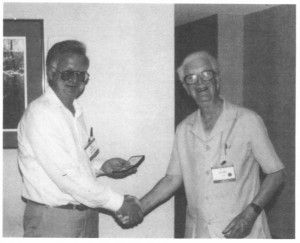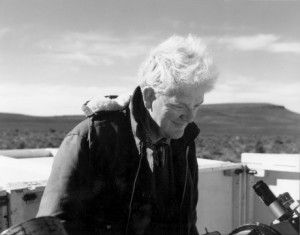| EVANS, David Stanley [FRAS] Dr. Professional Astronomer Born: 28 January 1916, Cardiff, Wales. Died: 14 November 2004, Austin, Texas. |
|
|
|
|
| Famous for: Co-author of a superb work on John Herschel and his time at the Cape. Chief Assistant at the Cape Observatory 1935-1950 (Director was Stoy 1935-1950) Professor of Astronomy at the University of Texas. (1968- ?) Associate Director of Macdonald Observatory (1968- ?) Co-developed the Barnes-Evans relation.Summary: Evans was a brilliant student, and did most of his Tertiary Studies in England during the disruptive World War Two years. He started his career in 1946 at the Radcliffe Observatory in Pretoria. Although he became Assistant Director of the Cape Observatory in 1951 he still had close ties with Radcliffe Observatory. In 1968 he moved to Texas as Professor in Astronomy at Texas University, as well as Associate Director of Macdonald Observatory. He Co-developed the Barnes-Evans relation for measuring distance and radii of Cepheid variables based on their surface brightness. Evans received an impressive amount of accolades and awards during his career. |
|
|
|
|
| History: David Stanley Evans was born on 28 January 1916 in Cardiff, Wales. He was the second son of Arthur Cyril Evans and his wife Kate (nee Priest) [Obituary – MNASSA, p.6] He was educated at Cardiff High School for Boys and King’s College, Cambridge, where he was a “Mayor Scholar” in 1934. He obtained a First Class in the Mathematics Tripos Part Two in 1936 and a Distinction in Part Three in 1937. Evans was elected a Fellow of the Royal Astronomical Society on 14 May 1937. He was a PhD student at Cambridge Observatory in 1937 – 8 under the supervision of R. van der Riet Wooley and obtained the degrees of MA and PhD in 1941, his thesis topic being “The formation of the Balmer Series of Hydrogen in Stellar Atmospheres”. [Obituary – MNASSA, p.6] Evans held the post of research assistant at University Observatory in Oxford during the World War Two Years, from 1938 to 1946, working with Madge Adam. He also worked as a medical physicist with Kurt Mendelssohn during the war. [Obituary – MNASSA, p.6] During the war period he acted as scientific advisory editor of the magazine Discovery, a precursor to the New Scientist. From October 1941 to December 1945 he was one of the editors of The Observatory. [Obituary – MNASSA, p.6] After the War, from 1946 to 1951, he was second assistant to Harold Knox-Shaw at the Radcliffe Observatory in Pretoria. They were the only academic members of staff, and had three unskilled laborers to help. [Obituary – MNASSA, p.6] This observatory was a brilliant establishment but they suffered from a lack of funds and other problems. Before the war Oxford University decided to move their Observatory to Pretoria South Africa. They ordered a 74-inch telescope, which for half a Century would be the largest telescope in South Africa. The telescope was ordered in 1935 but due to delays saw first light only in 1948. Evans had to assist in the installation of the telescope, including a modification to the main cell because the primary mirror was slightly thinner than planned. [Obituary – MNASSA, p.6] In 1949 Evans married Betty Hall Hart, daughter of Lt-Col R.C.H. Hart and Annie (nee Hall). They had two sons. He worked on photographic photometry of elliptical galaxies and published a photographic catalogue of planetary nebulae in collaboration with A.D. Thackeray. [Obituary – MNASSA, p.6] Evans constructed a aluminising plant capable of coating mirrors up to 15-inch (38 cm) in diameters. [Obituary – MNASSA, p.6] He designed and built a Newtonian spectrograph for the Radcliffe 74-inch telescope. In March 1951 Evans accepted the post of Chief Assistant at the Cape Observatory. This was however not the end of his relation with the Radcliffe Observatory, because due to their financial situation, Radcliffe leased about half of their observing time to the Cape Observatory. Evans still spent a lot of time at the Radcliffe Observatory due to this arrangement. [Smits; Obituary – MNASSA, p.6] Amongst other activities he obtained Newtonian photographs of southern galaxies which were published in a limited, photographically-produced “Cape Photographic Atlas of Southern Galaxies”. [Obituary – MNASSA, p.7] Evans did some measurements of stellar angular diameters using photometric and high speed recording. His results suggested that Antares was not symmetrical or was spotted. There was initial skepticism but more recent observations proved him right. [Obituary – MNASSA, p.7] He was involved in the selection of the site (at Sutherland) for the new S.A.A.O. observatory. [Obituary – MNASSA, p.7] In 1965 – 66 he was a National Science Foundation Senior Visiting Scientist Fellow at the University of Texas at Austin. [Obituary – MNASSA, p.7] In 1968 Evans attained the UK Civil Service rank of SPSO (Senior Principle Scientific officer). [Obituary – MNASSA, p.7] Evans resigned from the Cape Observatory on 4 October 1968 to become Professor in Astronomy at the University of Texas, as well as the Associate Director of Macdonald Observatory. He had students such as Bernard W. Bopp, Thomas J. Moffet, Francis C. Fekel and C.H. Lacey. [Obituary – MNASSA, pp.7 – 8.] In 1971 Evans received the ScD degree. During the years 1977 – 86 he was appointed Jack S. Josey Centennial Professor at the University of Texas. He became an Emeritus Professor in 1986. [Obituary – MNASSA, p.8] In 1973 he organised an eclipse expedition to Mauritania to obtain the general relativistic deflection of apparent stellar positions caused by the solar gravitational field. [Obituary – MNASSA, p.8] A very important contribution that Evans made to science concerns the cosmic distance scales. Arising from his occultation interests he co-developed what became known as the Barnes-Evans relation which connects the surface brightness of a star to its V-R colour. This enables the radii and distances of Cepheid pulsating variables to be determined from light, colour and radial velocity measurements around their pulsation cycles. [Obituary – MNASSA, p.8] Evans held the positions of President of the Radial Velocity Commission of the International Astronomical Union, as well as Secretary of its Galaxy Commission. He also received the Tyson Medal and a Raleigh prize from Cambridge University, and both the Gill Medal and Macintyre award from the Astronomical Society of Southern Africa. On retirement, he and his wife were made honorary citizens of Texas by the Governor. [Obituary – MNASSA, p.8] Evans died on 14 Novenber 2004 in Austin, Texas.Career: 1937 May 14: Elected a Fellow of the Royal Astronomical Society 1946 – 1951: Second Assistant at Radcliffe Observatory. 1951 – 1968: Chief Assistant at the Cape Observatory. 1965 – 66: National Science Foundation Senior Visiting Scientist Fellow at the University of Texas at Austin. 1968: UK Civil Service rank of SPSO (Senior Principle Scientific officer) 1968- ?: Professor of Astronomy at the University of Texas. 1968 – ?: Associate Director of Macdonald Observatory. 1971: Received ScD degree. 1973: Solar eclipse expedition to Mauritania. (General Relativity) 1977 – 86: Appointed Jack S. Josey Centennial Professor at the University of Texas. 1986: Emeritus Professor at the University of Texas. President of the Radial Velocity Commission of the International Astronomical Union. Secretary of the Galaxy Commission of the International Astronomical Union. Awards received by Evans: Personal: |
|
|
|
|
|
Link to the Telescope Manufacturers. |
|
| Radcliffe 74-inch (1.9m) Telescope | |
|
|
|
|
Link to the Main Bibliography Section and more information about Sources. |
|
| Remaining artifacts:Bibliography: Laing, J.D. (ed.), The Royal Observatory at the Cape of Good Hope 1820 – 1970 Sesquicentennial Offerings, p. 16. Moore, P. & Collins, P., Astronomy in Southern Africa, pp.84. (General Source) Obituary: MNASSA Vol. 64, Nos 1 & 2, February 2005. Smits, P., A Brief History of Astronomy in Southern Africa.(Unpublished) By Evans: Herschel at the Cape; Diaries and Correspondence of Sir John Herschel 1834 – 1838, with T.J. Deeming, Betty H. Evans and S. Goldfarb, University of Texas Press (also Balkema, Cape Town), 1969. |
|
|
|
|
| Related External Links: Third Speckle Catalog: Fourth Interferometric Catalog : Obituary: Univ. of Texas |
|
Gallery
 Evans receiving the Gill medal, South Africa’s highest award for Astronomy. The presenter is Ian Glass.
Evans receiving the Gill medal, South Africa’s highest award for Astronomy. The presenter is Ian Glass.


